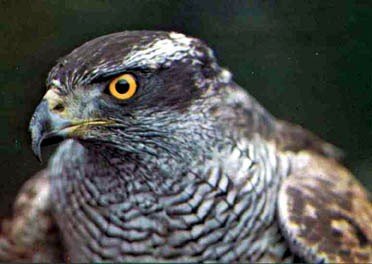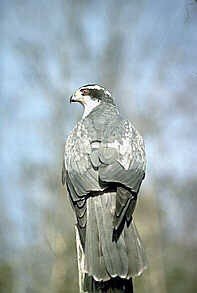Imperiled species highlight: The northern goshawk
Northern goshawks (Accipiter gentilis) are part of the Accipitridae family, which consists of hawks and eagles, and the subfamily Accipitrinae consisting of hawks, goshawks and sparrowhawks.
The northern goshawk is a large forest raptor that lives in the temperate and boreal forests in the Northern Hemisphere. Northern European, northern Asian and Middle Eastern hunters used northern goshawks historically for falconry. Falconry declined during the eighteenth century when guns began to dominate hunting methods.
Northern goshawks were used for falconry because their short powerful wings allow for rapid acceleration and long tail for quick maneuverability, making them exceptionally agile, which is necessary for hunting in the forest.
Considered a partial migrant, northern goshawks move according to food availability in breeding areas. Goshawks predate on tree squirrels, hares, grouse, corvids, woodpeckers, and large passerines such as the American Robin. They use a “sit and wait” hunting method, perching briefly while looking for food and then moving to a new perch. They kill their prey by driving their talons into the quarry and use a kneading action post-impact. In North America, the northern populations migrate south when snowshoe hare populations decline.
In Oregon, goshawks are a year-round inhabitant of the Cascade and Klamath-Siskiyou Mountains and range east of the Cascades at 1,900-6,100 ft.
The females are larger than the males, and northern goshawks are the largest of three North American Accipiters. The wingspan of the female reaches between 105-115cm and males, 98-104cm. Juveniles have a brown back and upperwings and a brown and white spotted chest. Juveniles also have a yellow eye that turns red with maturity. Adults are characterized by their blue-gray back and upperwings, white undertail coverts, and the white stripes above their eyes.
Goshawk nesting habitat is mature and old-growth forest consisting of large trees with high canopy closure (60-90%). In Oregon their nests are frequently found near forest gaps caused by downed trees or openings in understory conifers. They nest in the largest trees in a tree stand, usually in the lower third of the canopy. They will also use trees that died due to beetle infestation for several seasons.
Logging activities near nests can cause nesting failures, especially during incubation. Logging within 50-100 meters can cause abandonment even when 20-day-old nestlings are present. Post-abandonment, the goshawk may attempt to renest, but its not guaranteed.
Goshawks have some protection under the Migratory Bird Treaty Act of 1918, Sensitive Status species, and Category II Species of Concern by United States Fish and Wildlife Services. There have been two unsuccessful attempts to have the northern goshawk listed under the Endangered Species Act.
You can support our work to advocate for federal protections over wildlife like the northern goshawk by donating to our Wildlife Defense Fund.


